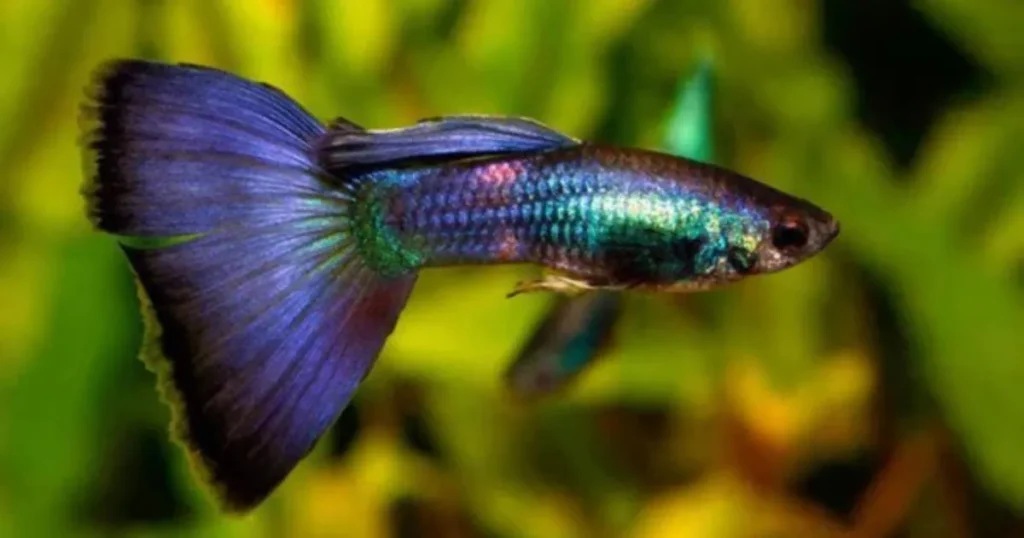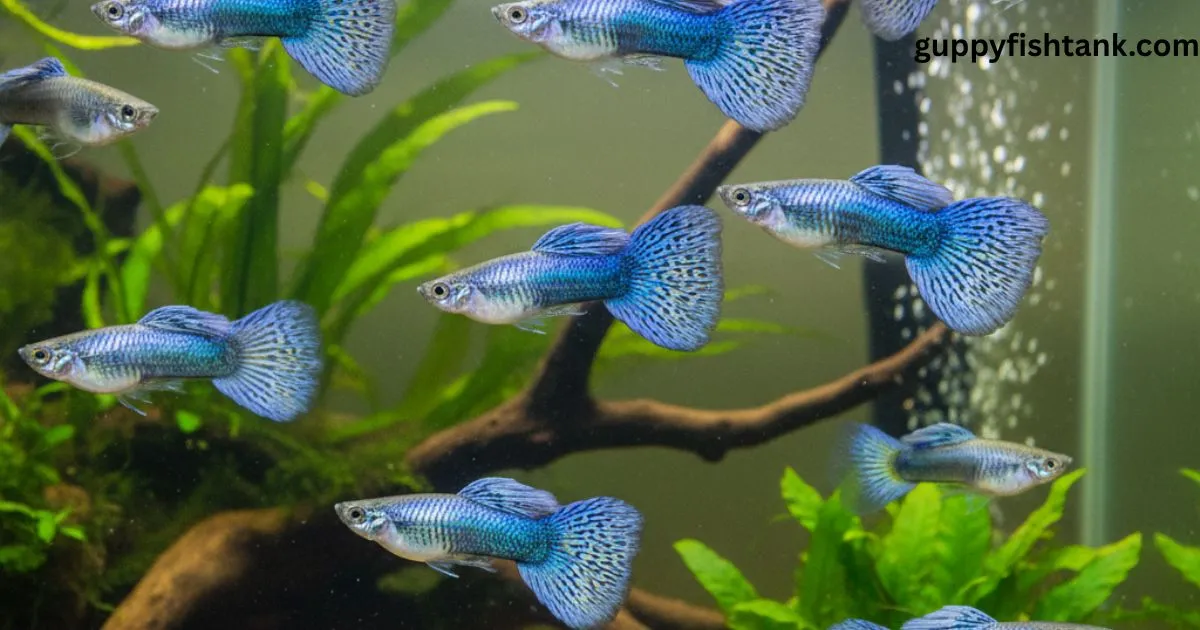Imagine a tiny fish shimmering in shades of blue, with lace like patterns that look like delicate embroidery on its fins and body. That’s the magic of blue lace guppies! These small but striking fish belong to the guppy family, scientifically called Poecilia reticulata, and are loved by aquarium hobbyists all over the world.
Blue lace guppies are special because of their beautiful metallic blue color combined with a unique lace or cobra pattern. They brighten up any aquarium and are a favorite among beginners and experts alike. They are peaceful, fun to watch, and bring a splash of color to your underwater world.
In this guide, you’ll learn everything you need to care for blue lace guppies, from setting up the perfect tank to understanding their diet, breeding, and even spotting common health problems. If you ever wondered about blue lace guppies, you’re in the right place!
The Lace Like Pattern and Metallic Blue Hues
The standout feature of these guppies is, without a doubt, their lace like pattern. Think of the fine threads of lace you might see on fancy clothes; that’s what their fins look like. This pattern gives them their name, blue lace guppy. Their bodies usually shine in metallic or bright blue hues, which change slightly depending on the light and angle.
But there’s more than one type. You might hear about Blue Metal Lace, Black Cobra, or other groups. Each strain has its own unique twist on the patterns and colors. For instance, the Black Cobra guppy has darker colors with snake like patterns, while the Blue Metal Lace has a shiny metallic finish on its scales.
When you watch them swim, their colors and patterns seem to dance and shimmer. It’s no surprise that these guppies are popular among fish lovers who want a splash of living art in their tanks.
Ideal Tank Setup and Environment
Setting up a home for your blue lace guppies doesn’t have to be complicated or expensive. But it does need to be just right!
First, size matters. A tank of at least 20 gallons (about 75 liters) is perfect for a small group of these little swimmers. They love space to swim and hide, so more room means happier, healthier guppies.
They also adore plants. Real or fake, plants provide hiding spots and make the tank look like a mini underwater forest. Blue lace guppies feel safer and more relaxed with plenty of places to explore or take a break.
Water conditions should be just like their natural home:
- Temperature between 72°F and 82°F (22°C to 28°C)
- pH level around 6.8 to 7.8 (a bit like neutral to slightly acidic water)
- Hardness between 8 and 12 dGH (that means the water isn’t too soft or too hard)
Keep the tank clean! Change about 20% of the water every week to make sure it’s fresh and comfortable.
Because blue lace guppies are peaceful fish, they do great with friends. Avoid aggressive species, and choose tank mates like snails, small tetras, or other calm fish. This way, everyone can live in harmony.
What Do Blue Lace Guppies Eat?

One of the best things about blue lace guppies is their simple appetite. They’re not picky and enjoy a variety of foods that keep them bright and healthy.
Their diet can include:
- High quality fish flakes specially made for guppies.
- Small pellets sized just right for their tiny mouths.
- Live or frozen foods like bloodworms, brine shrimp, or tubifex worms (these add extra protein)
- Plant based foods such as spirulina and vegetable flakes
Feeding them small amounts twice a day is perfect. Too much food can dirty your tank and make the fish sick. So, always give them only what they can eat in a few minutes.
A varied diet not only keeps your guppies full but also helps their colors stay bright and their energy high, so they can keep dazzling you with their beautiful blue lace patterns.
How Do Blue Lace Guppies Breed?

Ready to bring baby guppies into your aquarium? These little fish are livebearers, which means they give birth to tiny, fully formed baby fish instead of laying eggs. Breeding blue lace guppies is fun and rewarding, especially when you see those little fry (baby fish) swimming around.
To encourage breeding:
- Keep the water clean and stable.
- Offer plenty of hiding spaces for the females to protect their babies.
- Feed adults nutritious food that helps them stay healthy and ready to breed.
Pregnant females get rounder and might hide more often. This is normal, so give them privacy if you can. In about 4 weeks, you’ll see the fry swimming around!
To help the fry grow, feed them with crushed flakes, baby brine shrimp, or special fry foods. Keep water conditions smooth and avoid big fish that might want a quick snack!
Breeding your own blue lace guppies is a wonderful way to enjoy these stunning fish for years to come.
Common Health Issues and Preventive Care
Like all pets, blue lace guppies can get sick, but with the right care, you can avoid most problems.
Watch out for:
- Ich (white spots): Looks like tiny white grains on their fins and body. It’s common but easy to treat with aquarium salt or medicine.
- Fin rot: Edges of the fins look ragged or holey. Keeping water clean helps prevent this.
- Stress signs: If your guppies hide all the time or stop eating, something might be wrong. Check water quality and tank mates.
Healthy guppies show bright colors, swim actively, and eat happily. Regular tank cleaning and a balanced diet go a long way to keeping them in tip top shape.
The Role of Genetics in Blue Lace Guppies’ Appearance
Ever wondered how blue lace guppies get their stunning looks? It all comes down to genetics, the fish’s family history written in its DNA.
Breeders carefully select which guppies to mate to enhance the lace pattern or the shining metallic blue color. This selective breeding leads to unique combinations and sometimes rare color mixes.
If you enjoy watching different guppy types and patterns, genetics explains why each one looks special. Some strains are harder to keep or more expensive because their colors and patterns are rare.
Understanding genetics helps hobbyists appreciate the beauty and variety in their aquariums and can guide you if you want to breed your own beautiful blue lace guppies.
Where to Buy Quality Specimens
If you decide to get your own blue lace guppies, buying from a good source is key to success.
Look for:
- Fish that swim actively and have bright, even colors
- Clear eyes and smooth fins with no tears or spots
- Healthy behavior with no signs of disease
Specialty aquarium shops, online breeders, and fish clubs are great places to find quality blue lace guppies. Sexed pairs (male and female) are convenient if you want to start breeding right away.
Avoid fish from unclear sources to keep your aquarium safe and your fish healthy.
FAQs
How long do blue lace guppies live?
On average, with good care, blue lace guppies can live up to 2 to 3 years. A healthy tank and proper diet help them stay around longer.
Are blue lace guppies suitable for beginners?
Absolutely! Their hardy nature, peaceful personality, and simple care needs make them perfect for anyone new to fishkeeping. Just set up the tank well and feed them right, and you’ll have happy little swimmers.
Can blue lace guppies live in small tanks?
While blue lace guppies can survive in smaller tanks, it’s best to provide at least a 20 gallon (75 liters) tank to ensure they have enough space to swim freely and stay healthy. Smaller tanks can lead to poor water quality and stressed fish.
How often should I clean my blue lace guppy tank?
You should change about 20% of the tank water every week to keep it clean and fresh. Regular partial water changes help prevent harmful toxins and create a happy environment for your guppies.
What is the best way to tell male and female blue lace guppies apart?
Male blue lace guppies are usually smaller and more colorful, sporting brighter blue and lace patterns. Females tend to be larger with rounder bodies and duller colors, making them easy to distinguish.
Summary and Final Tips for Success
Blue lace guppies are a sparkle of life and color in any aquarium. Their lace like patterns and shimmering blues make them true underwater gems. By following good tank setups, feeding nutritious food, and keeping an eye on their health, you’ll have a thriving community of these beautiful fish for years.
Remember, guppies love space, clean water, and friends to swim with. With a bit of patience and love, you’ll enjoy watching the rainbow of blue lace guppies brighten your home, splash after splash.
